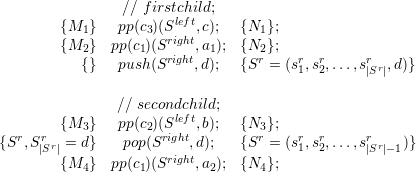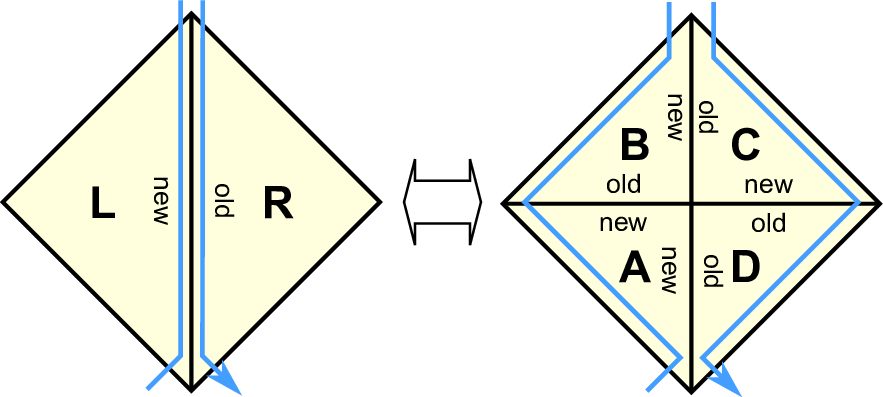The proof of the theorem is supported by axiomatic rules closely related to those of the Hoare
calculus [Hoa69]. We define inference rules given in the form  with A stating the condition
which has to hold true and B the condition to replace A. The conditions are given by a tuple of
tuples {{P}S{Q}}n with the precondition P, the code-statement S and the postcondition Q.
with A stating the condition
which has to hold true and B the condition to replace A. The conditions are given by a tuple of
tuples {{P}S{Q}}n with the precondition P, the code-statement S and the postcondition Q.
We further assume push and pop operations specified via push(S,a), pushing the element a to stack S, and pop(S,a) fetching element a from the stack.
The push and pop operations are extended with the pre- and postconditions

Reduction and commutative rules
Correct communication: The success of a correct pop operation by applying the grammar and inheritance of types lead to pop operations pop(S,α), testing for correct fetching of element α from the top of the stack. This leads to the rule
 | (4.15) |
This converts the pop operation into the pop operation introduced in Section 4.2, which allows
reduction:
Reduction: Correct communication via push/pop to/from stack Sk is recognized and reduced via
 | (4.16) |
This assures correct communication information received by the communication partner by pushing the same data α to the stack and fetching the same data α from the same stack. A reduction statement tests for such a correct communication and removes the statements, resulting in ϵ. We are allowed to do so, since the stack is kept in an unmodified state for all other edges accesses.
Commutativity: Commutative property for accessing different communication stacks

Joining consecutive communication data: In case of pushing or fetching edge data in the correct order with respect to the parent triangle allows to join data stored on the stack:

Application of inference rules
We apply the rules R1-R8 to show the valid stack access for edge-based communication. Considering only new and old communication types, the proof is given without loss of generality by boundary edges assumed to not modify any communication stacks. For even traversals, the access order for the root triangle only considering the edge access (see Section 4.3.2) is given by

We map each new and old communication type of edge data α to push(Sk,α) and pop(Sk,α) to/from stack Sk. To avoid verification for all push/pop combinations, we use a generalization of stack operations

For the parent element of type even, this leads to the push and pop operations

Our communication scheme with type inheritance




With our grids generated by the spacetree, we still have to prove the stack system for an entire grid. Without loss of generality, we only present this proof for diamond-shaped grid areas by applying coarsening rules, see Fig. 4.11.
We assemble two half-diamond operations (see Eqs. (4.20)) to operations of a full diamond and apply the coarsening operations. With operations on the right stack access represented by the symbol [X], this yields the following code
![{M1 } pp(c3)(Sleft,b); {N1 };
{M2 } pp(c2)(Sleft,c); {N2 };
{ } push (Sright,a1); {Sr = (sr,sr,...,sr r,a1)};
right r 1r 2r |rS |
{ } push (S ,a2); {S = (s1,s2,...,s|Sr|,a2)};
...[X ]... .
{Sr, Srr = a2} pop(Sright,a2); {Sr = (sr,sr,...,sr r )};
r |Sr | right r 1r 2r |rS |-1
{S ,S|Sr| = a1} pop(S ,a1); {S = (s1,s2,...,s|Sr|-1)};
{M7 } pp(c3)(Sleft,d); {N7 };
{M8 } pp(c2)(Sleft,e); {N8 };](schreiber14dissertation115x.png)


